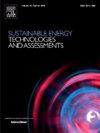GIS-based potential assessment for pumped storage hydropower using existing reservoirs in China
IF 7
2区 工程技术
Q1 ENERGY & FUELS
Sustainable Energy Technologies and Assessments
Pub Date : 2025-05-26
DOI:10.1016/j.seta.2025.104366
引用次数: 0
Abstract
Enhancing existing reservoirs with upper reservoirs for pumped storage hydropower (PSH) is a promising approach for PSH development. However, large-scale site selection and capacity assessment for PSH face significant challenges due to diverse topographic conditions. This study proposes a large-scale PSH potential assessment model leveraging GIS to identify potential upper reservoir sites in mountainous and flat terrains based on existing reservoirs. For the first time, the theoretical and realizable potential of this PSH development approach in China is comprehensively evaluated. Furthermore, the applicability of this methodology across various topographical conditions is compared and validated. A case study of 532 large reservoirs from the GRanD dataset reveals that China’s overall theoretical PSH potential is approximately 9,671 GWh. The realizable potential (8,717 GWh) is roughly 1.74 times the country’s current planned and reserved PSH capacity. The potential sites are primarily located in the flat terrain areas (86% of the total storage potential) and are geographically distributed in the northwest and southwest regions (79% of the total storage potential). Qinghai Province in the northwest exhibits the largest potential, contributing 32% of the total storage potential. The maximum tunnel length significantly impacts PSH potential, with the 20-km tunnel scenario demonstrating approximately 5.5 times the potential of the 5-km tunnel scenario.
基于gis的中国既有水库抽水蓄能潜力评价
利用上游水库加强现有水库进行抽水蓄能发电是一种很有前途的抽水蓄能开发方法。然而,由于地形条件的多样性,PSH的大规模选址和容量评估面临着重大挑战。在现有水库的基础上,提出了一种利用地理信息系统(GIS)识别山地和平原上潜在水库的大尺度PSH潜力评价模型。本文首次综合评价了这种PSH开发方法在中国的理论和可实现潜力。此外,该方法在各种地形条件下的适用性进行了比较和验证。对GRanD数据集中的532个大型水库的案例研究表明,中国的总体理论PSH潜力约为9,671 GWh。可实现的潜力(8,717 GWh)大约是该国目前计划和保留的PSH容量的1.74倍。潜在站点主要位于平坦地形地区(占总存储潜力的86%),地理分布在西北和西南地区(占总存储潜力的79%)。西北的青海省潜力最大,占总蓄能潜力的32%。隧道的最大长度会显著影响抽水蓄能,其中20公里隧道方案的抽水蓄能约为5公里隧道方案的5.5倍。
本文章由计算机程序翻译,如有差异,请以英文原文为准。
求助全文
约1分钟内获得全文
求助全文
来源期刊

Sustainable Energy Technologies and Assessments
Energy-Renewable Energy, Sustainability and the Environment
CiteScore
12.70
自引率
12.50%
发文量
1091
期刊介绍:
Encouraging a transition to a sustainable energy future is imperative for our world. Technologies that enable this shift in various sectors like transportation, heating, and power systems are of utmost importance. Sustainable Energy Technologies and Assessments welcomes papers focusing on a range of aspects and levels of technological advancements in energy generation and utilization. The aim is to reduce the negative environmental impact associated with energy production and consumption, spanning from laboratory experiments to real-world applications in the commercial sector.
 求助内容:
求助内容: 应助结果提醒方式:
应助结果提醒方式:


